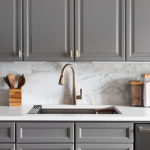Whether you’re renovating a room, laying flooring, or purchasing wall panels, understanding how to calculate square metres is essential for accurate planning. It helps avoid over-ordering or underestimating materials, saving both time and money. Knowing how to work out square metres also helps communicate more effectively with suppliers and contractors, ensuring a smoother project process.
What Is a Square Metre?
A square metre (m²) is a standard unit of area used in many construction and interior design projects. It represents the area of a square that is one metre long and one metre wide. When measuring any surface area—such as walls, floors, or ceilings—expressing it in square metres helps determine how much material is needed to cover it.
Basic Formula to Calculate Square Metres
The formula for calculating square metres is simple:
Length × Width = Area in square metres
For example, if you are measuring a rectangular room that is 4 metres long and 3 metres wide:
4 m × 3 m = 12 m²
This means the total surface area of the floor is 12 square metres.
Measuring Irregular Spaces
Not all rooms or surfaces are perfect rectangles. For areas with irregular shapes, it’s helpful to break the space into smaller rectangular sections. Measure each section individually, calculate the area for each, then add them together to get the total square metres.
For example, if one part of a room measures 2 m × 3 m and another section is 1 m × 2 m:
2 × 3 = 6 m²
1 × 2 = 2 m²
Total = 6 m² + 2 m² = 8 m²
This approach ensures that even non-standard layouts are measured accurately.
How to Measure Walls and Floors
To measure floors, simply record the length and width of the floor area in metres. For walls, measure the height and width of each wall. If you’re installing panels or painting, you’ll need the total wall area.
If a wall is 2.5 metres high and 4 metres wide:
2.5 m × 4 m = 10 m²
Repeat for each wall and add the areas together for the total coverage.
Consider Openings and Fixtures
When calculating wall or floor area, don’t forget to account for any windows, doors, or built-in fixtures that won’t be covered. Measure the area of these features and subtract them from the total.
For instance, if a window measures 1.2 m × 1.5 m:
1.2 m × 1.5 m = 1.8 m²
Subtract this from the total wall area to avoid buying unnecessary material.
Tips for Accurate Planning
- Use a tape measure and ensure it’s level when taking measurements.
- Double-check each measurement before calculating.
- Record measurements in metres, not centimetres, to avoid conversion errors.
- Round up slightly to allow for cutting or fitting adjustments.
- Add 5–10% extra to your final total as a buffer for waste or errors.
Conclusion
Learning how to work out square metres is a valuable skill that simplifies project planning, ensures cost efficiency, and avoids unnecessary delays. With a clear understanding of how to measure and calculate accurately, you can confidently plan for any space, from a small bathroom to a large open-plan area. Whether you’re installing flooring, tiling walls, or fitting panels, square metre calculations are the foundation of a successful outcome.






